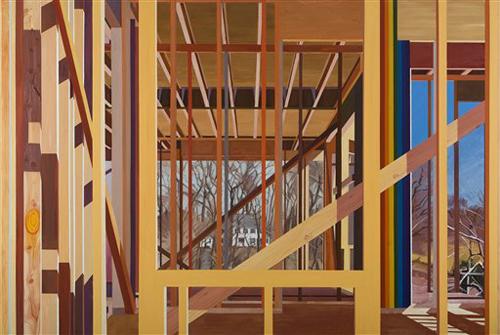Last arts frontier: Walker exhibit explores, explodes suburbia myths
Feb 15, 2008
MINNEAPOLIS – There’s hardly a landscape that’s attracted more scorn from artists than the suburb. Think of what the movie “American Beauty” did to explode the myth of happy tranquility behind manicured lawns and sprawling McMansions.
But could the much-maligned suburb, with its cul-de-sacs and big-box megastores, actually be the American landscape of choice, and a good one at that? Should architects, so focused on revitalizing cities, turn their creative powers to suburban planning?
Those are the kind of questions provoked by “Worlds Away: New Suburban Landscapes,” which opens at the Walker Art Center on Saturday. With more than 75 works ranging from architectural models of strip mall parking lots to large photographs of eerily empty mansions, the exhibit explores the history, the stories and the possible future of the suburb.
“You can’t afford to ignore it. It’s just too big,” says co-curator Andrew Blauvelt, design director at the Walker.
Big is a defining characteristic of suburbs and one of the reasons they came to be. In the 1950s, people took advantage of ever-popular cars and expanding highway systems to flee crowded, polluted, crime-ridden cities, and sought to recreate their creature comforts in closer contact with nature.
Get The Daily Illini in your inbox!
Large photographs such as Andrew Bush’s “Man traveling southeast on U.S. Route 101 at approximately 71 mph somewhere around Camarillo, California, on a summer evening in 1994,” are a reminder that freedom on the road was one motivation to leave the city behind – even if that freedom seems to have evolved into dreadful commutes and environmentally catastrophic traffic jams.
Some of the works are darker, attacking suburbs for their often conspicuous waste and the not so idyllic realities they can mask. Lee Stoetzel’s “McMansion 2” satirizes the vast scale of some suburban homes with its illustration of a mansion made of leftover McDonald’s food, down to the cheese-slice sidings and cup-lid windows. Larry Sultan’s photographs of southern California homes seem a real-life version of Wisteria Lane, but closer inspection shows the homes serving as sets for adult movies.
The majority of the works, though, focus on the more benign aspects of life in suburbia, how it is changing and how it can be made more sustainable and community-oriented without transforming it into the city its dwellers didn’t like from the start.
Some are wistfully evocative, such as Chris Faust’s black-and-white early 1990s portraits of unsold new homes sitting on eerily empty lawns, painful in this time of booming foreclosures. Others are hopeful, like Julia Christensen’s and Paho Mann’s photographs of big-box stores and other strip mall fixtures that have been reclaimed as ethnic restaurants, schools, even churches.
Others are pure art. There may be no people in Edward Ruscha’s aerial shots of the parking lot surrounding the California State Department of Employment, but you can almost smell the despair of job seekers in the tire marks and the oil stains on the asphalt.
A series of detailed architectural models looks at the future. One is an intricate clover-shaped mall parking lot that incorporates landscaping and seeks to push people to interact rather than compete for the parking space closest to the entrance. Around San Diego, a parallel project envisions the remaking of a suburb to encourage community while another older suburb slated for demolition is being recycled over the border to build the periphery of Tijuana, Mexico.
“We need to accept reality and say what can be done to tweak it to accommodate users instead of vice versa,” says co-curator Tracy Myers of the Heinz Architectural Center at the Carnegie Museum of Art in Pittsburgh.
The suburb is already more appealing to more diverse people than most imagine. This exhibit suggests that with fewer cookie-cutter homes and more cutting-edge architecture, it might indeed be good news that suburbia is here to stay.
“Worlds Away” remains at the Walker until Aug. 17. It will be at the Carnegie Museum of Art in Pittsburgh from Oct. 4 to Jan. 18, 2009.






